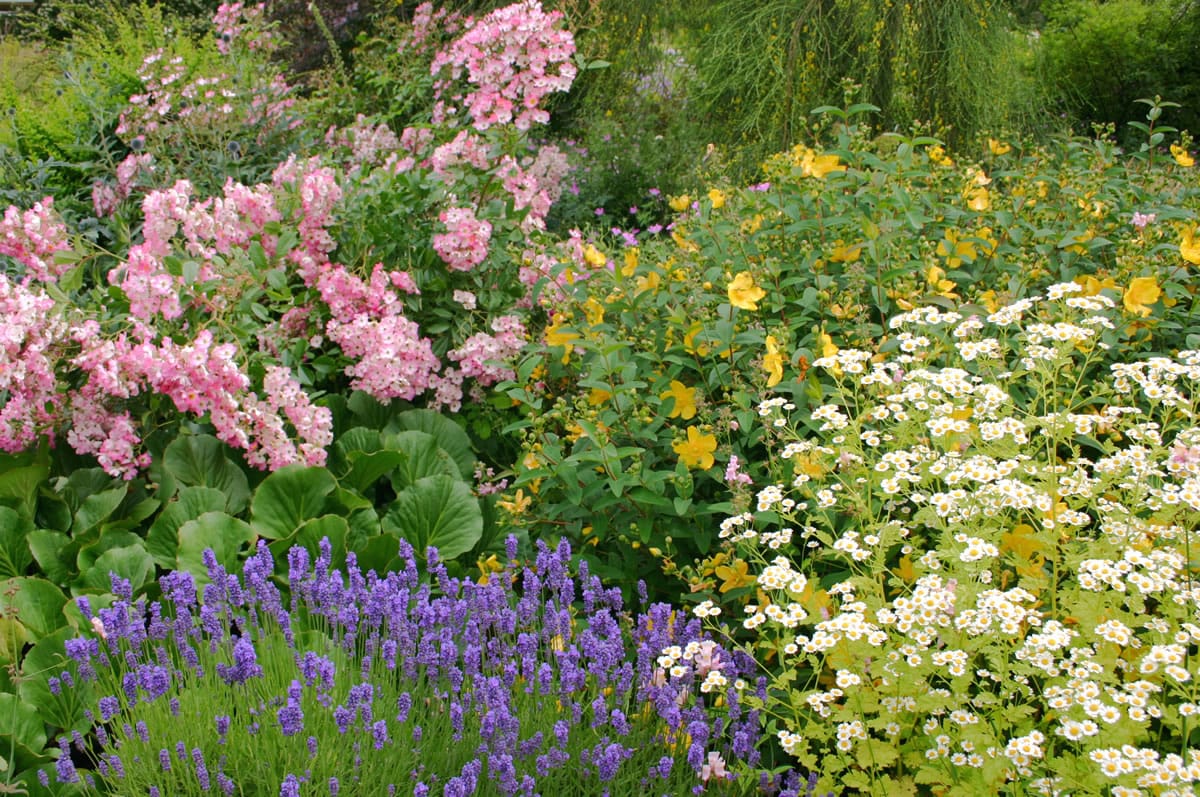The arrival of summer sets the stage for a wave of colorful perennials beginning with the peppermint Phlox subulata Candy Stripe’ and the azure Blue Star Creeper (Pratia pedunculata) covering the ground in waves of color. When the sun finally comes to stay, a mix of flowering shrubs, vines and perennials will take the color palette to new heights.
Because every garden is as unique as the gardeners who make them, there are no limits to the combination of plant choices and garden color. By watching nature through the seasons, we can all learn how to combine colors to create the look we want throughout the year. Look to seed, leaf, bark and fruit, as well as to any native flowers in the garden to bring that look alive.
Few things affect the overall look of a landscape as much as color. Since a person’s choice of color is
subjective, rules are little more than guidelines, made to be broken. We learn about plants and color by gardening over a period of time. Midsummer is one of the best times of the year to look around the garden and decide if your color choices are working for you.
A predominantly green garden, like you’d find around a cabin in the woods, is enough color for many people. Any gardener knows that green encompasses a vast array of differing hues. Look at the deep green of winter blooming hellebores, the muted neutral of Lady’s mantle (Alchemilla mollis) and the lime- or blue-green of many hosta varieties. An all-green garden, planned out and planted correctly, can be an intricate patchwork of mottled light and shade.
Hosta “Great Expectations” has huge leaves in a mix of blue, green and cream. Each color looks as if it was painted in thick strokes with a good-sized Chinese calligraphy brush. With three distinct colors on each leaf, this plant compliments a vast array of garden color. Blue and cream often act as neutral accents, bringing out the depth of other colors, enhancing the light and shade effects of the garden.
Don’t get stuck in the notion that you have to plant only the colors you have planted before. Being safe in the garden limits your opportunities. Be a pioneer and venture out on your own. Taking chances has opened the door to some of the best, most surprising color combinations in my own garden. One unexpected combination was Coreopsis “Zagreb” blooming alongside the daylily ‘Minnie Pearl’. I was pleasantly surprised by this cheerful combination of pink and yellow.
I try to be open about everyone’s choice of color in the garden, just as I try to be open about anyone’s personal plant preferences. One trait that I find disturbing is the outspoken person who lets everyone know, while looking at someone else’s garden, that they “hate yellow in the garden” or “won’t stand for an orange flower” springing up in one of their borders. Orange happens. If you don’t want it in your garden, you don’t have to plant it.
There is a certain play of color that comes with each new season. Summer is always good for a mix of deep, full-bodied hues of red, yellow and purple that hold color well under the noon-day sun. The family of rudbeckia, commonly known as Black-eyed Susan, is a favorite for deep orange-yellow to burgundy blossoms. Echinacea purpurea, the beloved Purple Coneflower, thrives in full sun and mixes well with almost any other garden color.
Summer is also the season of colorful bedding plants. Experiment with your favorite colors in brash, unexpected combinations. A large red planter filled to bursting with the vibrant orange, green and yellow striped leaves of the Canna Lily “Tropicana” will stand up to the sunniest location in your garden. Take it one step further by placing another brightly colored pot nearby planted with purple verbena and a host of Zinnia ‘Orange Profusion’.
Every gardener knows that a garden is never finished and always changing. Part of gardening is being willing to take some chances when making color choices. The best choices are those that please the person we are today. Stray from the old standbys. Remember, we don’t have to get it right every time. Being gardeners, we are here for the long haul. The worst you can do is to make a mistake. In gardening, there will always be another summer and a chance to experiment with a new batch of color choices.
Robb Rosser is a WSU-certified master gardener. Reach him at Write2Robb@aol.com.



